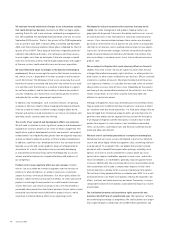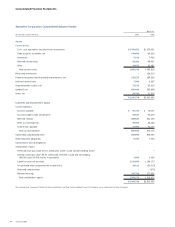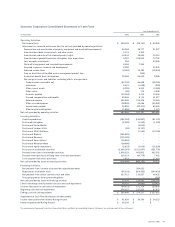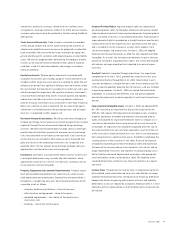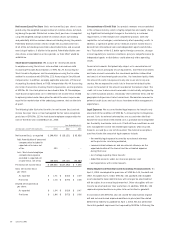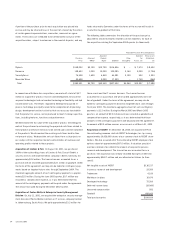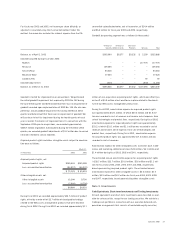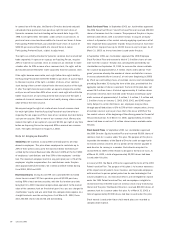Symantec 2003 Annual Report Download - page 52
Download and view the complete annual report
Please find page 52 of the 2003 Symantec annual report below. You can navigate through the pages in the report by either clicking on the pages listed below, or by using the keyword search tool below to find specific information within the annual report.
50 Symantec 2003
Net Income (Loss) Per Share Basic net income (loss) per share is com-
puted using the weighted average number of common shares outstand-
ing during the periods. Diluted net income (loss) per share is computed
using the weighted average number of common shares outstanding
and potentially dilutive common shares outstanding during the periods.
Potentially dilutive common shares include the assumed conversion
of all of the outstanding convertible subordinated notes and assumed
exercising of options, if dilutive in the period. Potentially dilutive com-
mon shares are excluded in net loss periods, as their effect would be
antidilutive.
Stock-Based Compensation We account for stock-based awards
to employees using the intrinsic value method in accordance with
Accounting Principles Board Opinion, or APB, No. 25, Accounting for
Stock Issued to Employees, and to nonemployees using the fair value
method in accordance with SFAS No. 123, Accounting for Stock-Based
Compensation. In addition, we apply applicable provisions of Financial
Accounting Standards Board, or FASB, Interpretation No. 44, Accounting
for Certain Transactions Involving Stock Compensation, an interpretation
of APB No. 25. Our stock plans are described in Note 12. No employee
stock-based compensation cost is reflected in net income (loss) related
to options granted under those plans for which the exercise price was
equal to the market value of the underlying common stock on the date
of grant.
The following table illustrates the effect on net income (loss) and net
income (loss) per share as if we had applied the fair value recognition
provisions of SFAS No. 123 to stock-based employee compensation for
each of the three years ended March 31, 2003:
Year Ended March 31,
(IN THOUSANDS, EXCEPT PER SHARE DATA) 2003 2002 2001
Net income (loss), as reported $248,438 $(28,151) $ 63,936
Add: Amortization of unearned
compensation included in
reported net income, net
of tax 253 ––
Less: Stock-based employee
compensation expense
excluded in reported net
income (loss), net of tax (89,036) (79,141) (56,680)
Pro forma net income (loss) $159,655 $(107,292) $ 7,256
Basic net income (loss)
per share:
As reported $1.71 $(0.20) $ 0.49
Pro forma $1.15 $(0.75) $ 0.06
Diluted net income (loss)
per share:
As reported $1.54 $(0.20) $ 0.47
Pro forma $1.06 $(0.75) $ 0.06
Concentrations of Credit Risk Our product revenues are concentrated
in the software industry, which is highly competitive and rapidly chang-
ing. Significant technological changes in the industry or customer
requirements, or the emergence of competitive products with new
capabilities or technologies, could adversely affect operating results. In
addition, a significant portion of our revenues and net income (loss) is
derived from international sales and independent agents and distribu-
tors. Fluctuations of the U.S. dollar against foreign currencies, changes
in local regulatory or economic conditions, piracy or nonperformance by
independent agents or distributors could adversely affect operating
results.
Financial instruments that potentially subject us to concentrations of
credit risk consist principally of cash equivalents, short-term investments
and trade accounts receivable. Our investment portfolio is diversified
and consists of investment grade securities. Our investment policy limits
the amount of credit risk exposure to any one issuer and in any one
country. We are exposed to credit risks in the event of default by the
issuers to the extent of the amount recorded on the balance sheet. The
credit risk in our trade accounts receivable is substantially mitigated by
our credit evaluation process, reasonably short collection terms and the
geographical dispersion of sales transactions. We maintain reserves for
potential credit losses and such losses have been within management’s
expectations.
Legal Expenses We accrue estimated legal expenses for lawsuits only
when both of the conditions of SFAS No. 5, Accounting for Contingencies,
are met. Costs for external attorney fees are accrued when the likeli-
hood of the incurrence of the related costs is probable and management
has the ability to estimate such costs. If both of these conditions are not
met, management records the related legal expenses when incurred.
Amounts accrued by us are not discounted. The material assumptions
used to estimate the amount of legal expenses include:
•the monthly legal expense incurred by our external attorneys
on the particular case being evaluated;
•communication between us and our external attorneys on the
expected duration of the lawsuit and the estimated expenses
during that time;
•our strategy regarding these lawsuits;
•deductible amounts under our insurance policies; and
•past experiences with similar lawsuits.
Newly Adopted and Recently Issued Accounting Pronouncements On
April 1, 2002, we adopted the provisions of SFAS No. 142, Goodwill and
Other Intangible Assets. Under SFAS No. 142, goodwill and intangible
assets deemed to have indefinite lives will no longer be amortized but
will be subject to an annual impairment test. Other intangibles will con-
tinue to be amortized over their useful lives. In addition, SFAS No. 142
required acquired workforce-in-place to be reclassified as goodwill.
In accordance with SFAS No. 142, we ceased the amortization of good-
will and recharacterized acquired workforce-in-place (and the related
deferred tax liability) as goodwill on April 1, 2002. We also performed
the initial goodwill impairment test required by SFAS No. 142 during the


